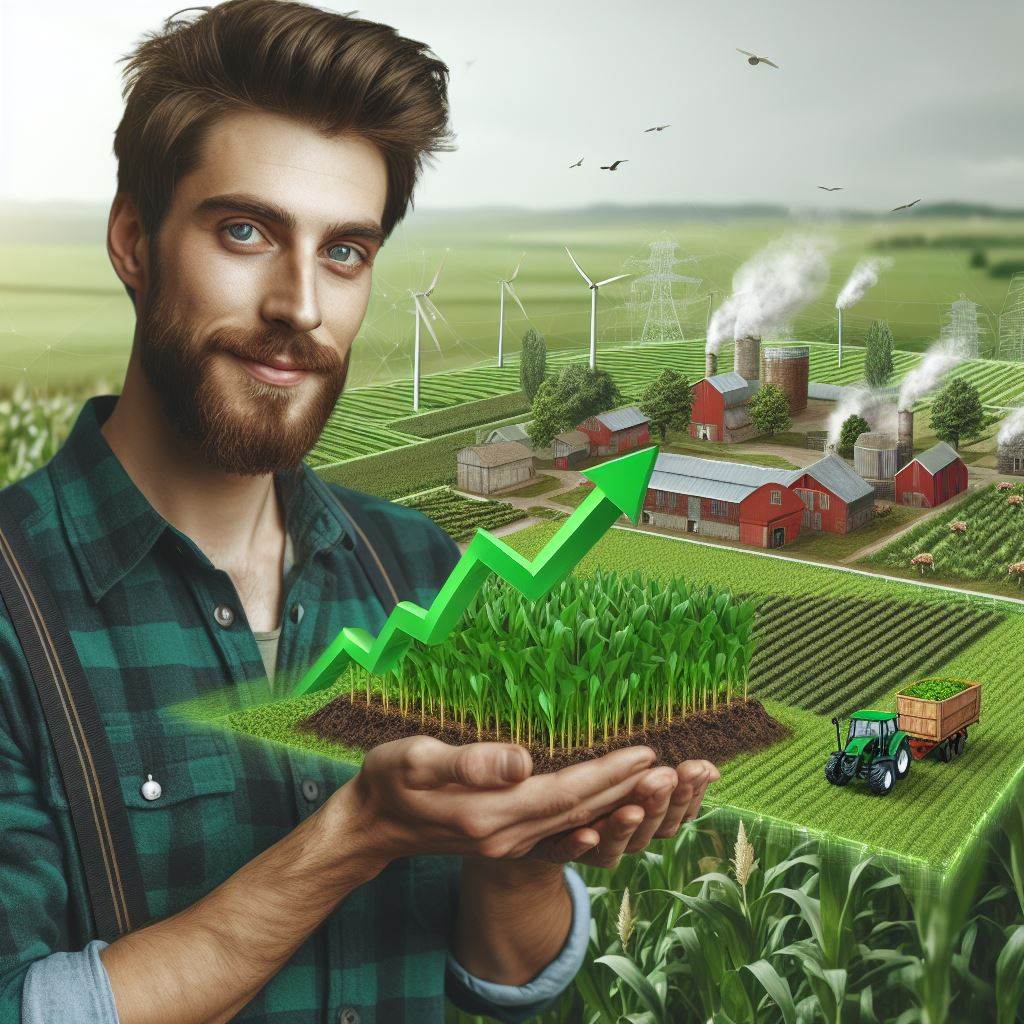Introduction
In this section, we will explore agricultural subsidies and their role in the farming industry.
Agricultural subsidies are financial aids provided by the government to farmers to support their agricultural activities.
These subsidies are crucial for the farming industry as they help to stabilize food prices and ensure food security.
This blog post aims to provide a comprehensive overview of agricultural subsidies, explaining their definition, importance, and purpose.
By the end of this section, readers will have a better understanding of how agricultural subsidies contribute to the farming industry’s sustainability.
Types of Agricultural Subsidies
Price support subsidies
Explanation of price stabilization through subsidies
Price support subsidies are government programs aimed at stabilizing agricultural product prices.
They involve providing financial assistance to farmers, ensuring a minimum selling price for their products.
This prevents drastic fluctuations in prices, which can adversely affect farmers’ income and the overall economy.
Examples of price support programs
One example of a price support program is the U.S. agricultural subsidy system.
Through this program, the government provides farmers with direct payments, loans, and price guarantees.
These measures encourage farmers to continue their production and ensure a stable food supply.
Income support subsidies
Description of income assistance programs for farmers
Income support subsidies focus on providing financial aid to farmers to supplement their income.
These programs aim to address the volatility in agricultural markets and help farmers maintain a stable livelihood.
They provide cash payments to farmers based on factors such as income, production, and commodity prices.
Examples of income support subsidies
The European Union’s Common Agricultural Policy (CAP) is an example of an income support subsidy program.
Transform Your Agribusiness
Unlock your farm's potential with expert advice tailored to your needs. Get actionable steps that drive real results.
Get StartedUnder the CAP, farmers receive direct payments based on historical production levels and eligible land.
This program aims to provide income stability and support sustainable agricultural practices.
Input subsidies
Explanation of subsidies for inputs such as seeds, fertilizers, and machinery
Input subsidies cover the costs of essential agricultural inputs, including seeds, fertilizers, and machinery.
These subsidies aim to lower the production costs for farmers, making agricultural activities more affordable and profitable.
By reducing financial burdens, input subsidies ultimately benefit both farmers and consumers.
Examples of input subsidy programs
India’s fertilizer subsidy program is one of the largest input subsidy programs in the world.
It provides farmers with subsidized fertilizers, ensuring affordable access to essential nutrients for crop production.
Similarly, countries like Brazil and China offer subsidies on agricultural machinery, helping farmers modernize their operations.
In essence, agricultural subsidies come in various forms, each with its own purpose and impact.
Price support subsidies stabilize market prices, income support subsidies provide financial assistance to farmers,
and input subsidies reduce the cost of essential agricultural inputs.
Together, these subsidies strive to support the agricultural sector, ensure food security, and promote sustainable farming practices.
Read: Navigating Land Use for Organic Farms
Benefits of Agricultural Subsidies
Agricultural subsidies have garnered significant attention and debate in recent years.
Critics argue that these government financial incentives distort markets, create inefficiencies, and cause environmental problems.
While there are valid concerns, it is essential to recognize the benefits that agricultural subsidies bring to society.
This section examines three key advantages of implementing agricultural subsidies.
Ensuring food security
One of the primary benefits of farm aid is the assurance of food security.
By providing financial support to farmers, subsidies promote stable food production.
This stability directly translates into a consistent supply of food for consumers. Without subsidies, farmers may struggle financially, leading to reduced agricultural output and potential food shortages.
Furthermore, farm aidimpact the availability and affordability of food.
Farmers who receive subsidies can afford to produce food at lower costs, enabling them to sell products at competitive prices.
Consequently, consumers benefit from lower prices, making food more accessible and affordable.
Supporting rural economies
Another crucial advantage offarm aid is their role in supporting rural economies.
Many farming communities heavily rely on subsidies to sustain their livelihoods.
Showcase Your Farming Business
Publish your professional farming services profile on our blog for a one-time fee of $200 and reach a dedicated audience of farmers and agribusiness owners.
Publish Your ProfileWithout subsidies, these rural areas would experience economic decline, leading to population migration and the loss of rural infrastructure and services.
Subsidies benefit local economies by providing financial stability to farmers.
The funds received by farmers create a ripple effect, stimulating local businesses and job creation.
For example, subsidies allow farmers to afford equipment and machinery, benefiting local agricultural machinery dealers.
Additionally, the increased income of farmers leads to more spending within their communities, further boosting the local economy.
Promoting domestic production
Lastly, agricultural subsidies play a vital role in promoting domestic production.
By incentivizing and protecting domestic farming, subsidies encourage self-sufficiency.
They provide financial resources that enable farmers to invest in their operations, such as purchasing new technology, improving infrastructure, and conducting research and development.
Reducing reliance on imports for national food security is crucial.
Subsidies help achieve this goal by ensuring a strong domestic agriculture sector.
Without subsidies, countries may become overly reliant on imported food, making them vulnerable to fluctuating international markets and potential disruptions in supply chains.
In fact, agricultural subsidies offer various benefits to society.
They ensure food security by promoting stable food production and impacting the availability and affordability of food.
Moreover, subsidies support rural economies, preventing their decline and contributing to local job creation.
Lastly, they play a vital role in promoting domestic production, reducing reliance on imports for national food security.
While there are valid concerns to address, the advantages of agricultural subsidies demonstrate their significant contribution to the wellbeing of farmers, consumers, and the overall economy.
Read: Urban vs Rural Zoning: A Deep Dive

Criticisms of Agricultural Subsidies
Agricultural subsidies have long been a contentious issue, with proponents arguing for their necessity in supporting farmers and ensuring food security.
However, critics highlight several key concerns associated with these subsidies – distorted market prices, environmental degradation, and distributional effects.
Distorted market prices
One major criticism of farm aid is their impact on market prices.
When subsidies are used to support farmers, they can lead to overproduction, which in turn lowers prices.
This creates imbalances in the market, causing difficulties for farmers who do not receive subsidies.
Additionally, subsidies can distort global trade by giving unfair advantages to subsidized farmers, compromising the competitiveness of farmers from non-subsidized regions.
Environmental concerns
The environmental implications of agricultural subsidies are another point of criticism.
Subsidies often incentivize unsustainable land use practices, as farmers seek to maximize production to benefit from the subsidies.
This can lead to the destruction of natural habitats, soil erosion, and water pollution.
Examples of environmental degradation caused by subsidy-driven production practices include deforestation for increased farmland and excessive fertilizer usage, resulting in nutrient runoff and harmful algal blooms in nearby water bodies.
Distributional effects
Furthermore, the distributional effects of farm aid raise concerns about equity and social justice.
Larger farms and corporations tend to benefit the most from subsidies, as they have the resources to exploit the subsidy programs effectively.
This concentration of benefits not only creates an uneven playing field but also undermines the viability of small-scale farmers and their communities.
These smaller farmers face disadvantages in terms of access to subsidies, market competitiveness, and financial stability, often leading to their marginalization and decline.
Addressing the criticisms of farm aid requires careful consideration and reform.
Efforts should be made to ensure subsidies do not distort market prices, by implementing mechanisms that prevent overproduction and reduce reliance on subsidies.
Environmental concerns could be addressed by incorporating sustainability as a condition for receiving subsidies, promoting responsible land use practices, and providing support for conservation efforts.
Reducing the concentration of subsidies on larger farms and corporations can be achieved by implementing policies that prioritize supporting small-scale farmers and their communities, promoting diversity and the resilience of the agricultural sector.
In review, criticisms of farm aid highlight the negative consequences associated with these support systems.
Distorted market prices, environmental degradation, and distributional effects all contribute to the need for reforming subsidy programs.
By addressing these concerns, farm aid can be transformed into effective tools for promoting equitable and sustainable agricultural practices, contributing to a healthier and more balanced agricultural sector globally.
Read: Zoning Laws Impact on Small Farms
Policy Considerations and Future Outlook
As we explore the topic of farm aid, it is important to assess the current policies in place as well as evaluate potential alternatives.
Showcase Your Farming Business
Publish your professional farming services profile on our blog for a one-time fee of $200 and reach a dedicated audience of farmers and agribusiness owners.
Publish Your ProfileThis section will delve into the policy considerations and future outlook for farm aid.
Current policies and reform efforts
Overview of existing subsidy programs and their effectiveness
It is crucial to examine the various subsidy programs currently in effect and assess their impact on agriculture.
This evaluation provides insights into the efficiency and effectiveness of these subsidies.
By understanding the strengths and weaknesses of these programs, policymakers can make informed decisions regarding necessary reforms.
Discussion on ongoing initiatives to improve subsidy distribution and impact:
Recognizing the need for improvement, ongoing initiatives aim to enhance the distribution and impact of agricultural subsidies.
These efforts focus on streamlining the distribution process, ensuring fair access to subsidies, and maximizing their positive effects on the agricultural sector.
By actively seeking ways to enhance the current system, policymakers can ensure that subsidies reach the intended beneficiaries and contribute to the growth and sustainability of the agricultural industry.
Potential alternatives to agricultural subsidies
Explanation of alternative frameworks, such as risk management programs or direct payments
As agricultural subsidies face scrutiny, alternatives such as risk management programs and direct payments gain importance.
Risk management programs involve strategies to mitigate the impact of unforeseen events, such as natural disasters and market fluctuations, on farmers’ incomes.
Direct payments, on the other hand, provide farmers with financial support without linking it to specific production levels or practices.
Exploring these alternative frameworks enables policymakers to consider different approaches in supporting farmers and ensuring their economic stability.
Consideration of the pros and cons of different approaches
When evaluating potential alternatives to agricultural subsidies, it is essential to consider the advantages and disadvantages of each approach.
Factors such as administrative complexity, potential distortions in market dynamics, and budgetary implications must be carefully weighed.
Analyzing the pros and cons enables policymakers to assess the feasibility and sustainability of alternative frameworks, ultimately leading to better-informed policy decisions.
In short, policy considerations and the future outlook for agricultural subsidies involve assessing the effectiveness of current programs, exploring ongoing initiatives to improve their distribution and impact, and considering potential alternatives.
By actively engaging in these discussions and evaluations, policymakers can implement policies that support the agricultural sector effectively.
The understanding of the strengths and weaknesses of existing programs, coupled with the exploration of alternative frameworks, enables the development of robust and sustainable agricultural policies.
Read: Impact of NAFTA on American Agriculture in 2024
Conclusion
Recap of key points discussed in the blog post
Throughout this blog post, we have explored the concept of agricultural subsidies and their implications.
We started by defining agricultural subsidies as financial incentives provided by governments to support farmers.
Next, we examined the reasons behind the implementation of such subsidies, including ensuring food security, promoting rural development, and maintaining a stable agricultural sector.
However, we also discussed the negative consequences of agricultural subsidies, such as distorting market prices, encouraging overproduction, and harming developing countries’ economies.
Final thoughts on the significance of agricultural subsidies
Agricultural subsidies have a significant impact on the global economy and farming communities worldwide.
While they aim to provide support to farmers, we must carefully consider the unintended consequences that may arise.
As we move forward, it is crucial to strike a balance between the need for agricultural subsidies and their potential negative effects.
Continual evaluation and reform of these policies will be essential to ensure fair and sustainable farming practices.
Encouragement to further explore the topic and engage in the ongoing debate
This blog post only scratches the surface of the complex issue of agricultural subsidies.
We encourage readers to dive deeper into this subject and explore various perspectives.
Engage in discussions with experts, farmers, policymakers, and fellow readers to gain a comprehensive understanding of the topic.
By actively participating in the ongoing debate surrounding agricultural subsidies, we can collectively work towards more effective and equitable policies that benefit both farmers and consumers.




